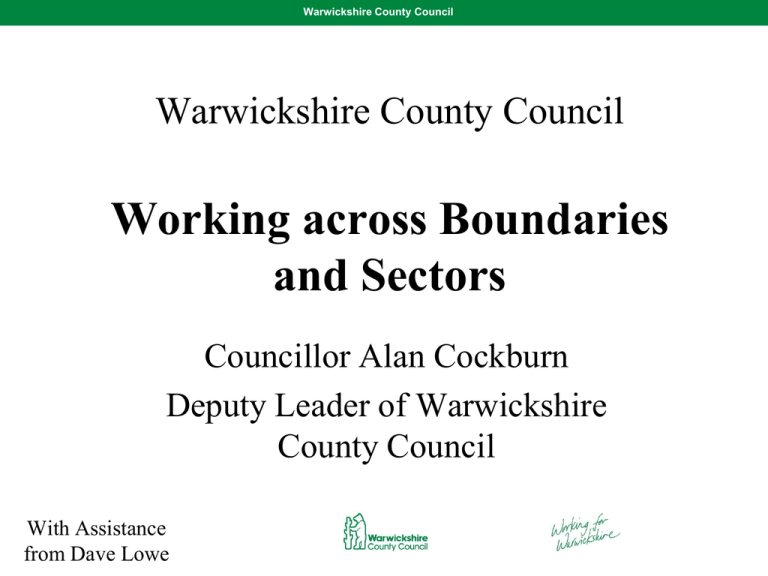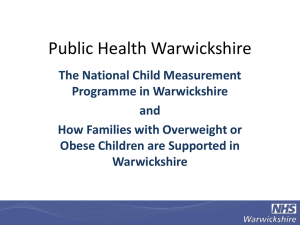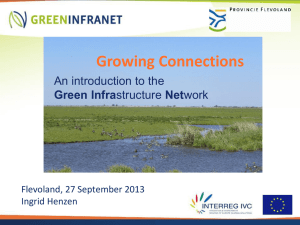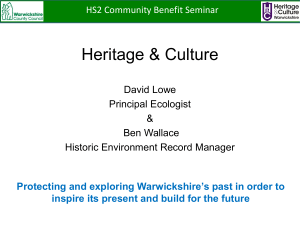CllrCoburn_LNP(version2) - Warwickshire Wildlife trust
advertisement

Warwickshire County Council Warwickshire County Council Working across Boundaries and Sectors Councillor Alan Cockburn Deputy Leader of Warwickshire County Council With Assistance from Dave Lowe Warwickshire County Council Proud History • In 1974 WCC established the Warwickshire Biological Record Centre • 5 Country Parks & 3 Greenways on 1,500 acres accessed by over 800,000 people each year • In 1994 Established an Ecology Unit • Placed solar panels on its Barrack Street building • 2014 Piloting national Biodiversity Offsetting initiative Warwickshire County Council Biodiversity Duty Natural Environment and Rural Communities Act 2006 Section 40 Duty to conserve biodiversity “Every public authority must, in exercising its functions, have regard, so far as is consistent with the proper exercise of those functions, to the purpose of conserving biodiversity.” Warwickshire County Council Warwickshire County Council Biodiversity Strategy Aims and Objectives “To work with partners to protect and enhance existing and future wildlife populations and habitats in Warwickshire, within a resilient landscape” Our Strategy to achieve this aim is to increase the amount of land and buildings positively managed for biodiversity, averting local extinction of species and reducing the number of species on the danger list. Warwickshire County Council Biodiversity Strategy The Council grouped the 12 Government ‘Aspects where LA’s should integrate biodiversity’ into 6 key strands and set objectives: Data and information – To obtain, manage, maintain and disseminate environmental data to inform decision-making and monitor changes. Regulation– To ensure that the Council considers biodiversity in exercising all of its statutory regulatory functions Management of our own Estate – To improve the management of all current and future council owned land and buildings with regard to biodiversity. Education and Learning – To build upon existing opportunities for both formal and informal learning with regard to the natural world. Community Leadership – To act as an exemplar to others in incorporating biodiversity into strategies and within partnership working by promoting best practice for the protection of Warwickshire’s biodiversity. Reporting and Review – To establish and maintain an internal reporting mechanism to inform and report on how WCC is actively considering biodiversity. Warwickshire County Council Biodiversity Strategy Warwickshire County Council Waste Prevention / Reuse Schemes introduced New re-use shops installed at the HWRCs Love Food, Hate Waste Support to open new reuse warehouses Home Composting/Master Composter Scheme Master Gardener Scheme Home Chipping service Junk Mail Real Nappies Warwickshire County Council Home Composting Over 26,000 compost bins sold since 2005 17% households composting Saving over 5100 tonnes of waste per year going to landfill 30 Master Composters trained and active Over 200 community events attended Warwickshire County Council Trading Standards Service Animal Health Officers attend livestock markets, farms and shows ensuring the welfare of animals. provides consumer confidence in the food allows rural businesses to thrive and grow Provides advice and guidance to Livestock farms claiming Single Payment Scheme helping them comply with cross compliance inspections. helps farmers with the upkeep of the countryside enables the community to enjoy all of its benefits. Warwickshire County Council Sub-regional GI Strategy Vision A diverse and well-managed Warwickshire, Coventry and Solihull Green Infrastructure network that underpins the quality of life for communities. This will be the result of a well-connected, accessible and biodiversity resilient landscape, supporting economic growth, social health and climate change adaptation. The strategy covers the disciplines of • Landscape • Biodiversity • Accessibility Warwickshire County Council Biodiversity Offsetting The Warwickshire, Coventry and Solihull sub-region was chosen as one of the 6 national pilot areas to trial biodiversity offsetting for 2 years. (April 2012 to March 2014). Biodiversity offsetting is where conservation activities deliver biodiversity benefits in compensation for biodiversity loss, in a measurable way. It has the potential to deliver effective, widespread biodiversity gain. Warwickshire County Council WCC Flood Risk Management • Flood risk management schemes seeking to work with natural processes wherever possible. • Looking for opportunities for biodiversity enhancement as part of flood risk management schemes. • Seeking to work in partnership with the Warwickshire Wildlife Trust and Woodlands for Water project to identify mutual wins for flood risk management and biodiversity. • Investigating options for a catchment management pilot study working with the Environment Agency. • Encouraging above-the-ground sustainable drainage on new developments. • Working closely with the NFU to try to improve land management for flood risk management purposes while keeping biodiversity in view (for example, ditch clearance outside the nesting season). Warwickshire County Council Environmental Management WCC is certified to the international environmental management system standard ISO 14001 as an auditable way of reducing risks and implementing improvements: • Prevent pollution • Reduce the amount of waste sent to landfill • Reduce energy/fuel use Examples of initiatives are:• Registration as a centre to deliver Waste Smart course • Corporate recycling scheme in place • Chemical-free cleaning in corporate buildings • Solar PV on suitable buildings • Energy efficient lighting Warwickshire County Council Campaign for the Farmed Environment (CFE) The Council has attended the Warwickshire pilot area steering group since its inception in 2009: The Campaign for the Farmed Environment (CFE) is encouraging farmers and land managers across England to protect and enhance the environmental value of farmland, through measures that sit alongside productive agriculture. Warwickshire County Council Marsh Christian Awards 2013 Promotion of Lepidoptera (Butterflies and Moths) Awarded to Warwickshire County Council for: • Ecology Unit being proactive in Butterfly Conservation and biological record exchange projects • Country Parks being proactive in the Silver-washed Fritillary Princethorpe Woodlands Project 26 breeding sites • Highways being proactive in the SITA Small Blue project where at Southam Bypass • Country Parks and some WCC Farms are in Higher Level Stewardships • Ecology Unit involving Warks Butterfly Conservation in planning decisions and compensation schemes Warwickshire County Council Marsh Christian Awards 2013 Promotion of Lepidoptera (Butterflies and Moths) “We think that Warwickshire County Council are doing a tremendous job, and are extremely worthy winners of this award. We want to build upon Warwickshire's exemplar work by spreading their good practice to other regions.” David Dennis's (Chair of Butterfly Conservation) Clearance and wild strawberry planting, at Paget’s Pool (Ryton) Warwickshire County Council High Speed Train (HS2) • Listening to Local Action Groups and Parish Councils • WCC to scrutinise Heritage Memorandum and Environmental Statements being produced by HS2 • HS2 close to several Listed Buildings • Mitigation measures required to reduce severed wildlife corridors • WCC also Chairs the Line-wide Ecology Technical Group Warwickshire County Council High Speed Train (HS2) “Features such as the use of green bridges, tunnels, ‘buffering’ habitats and green boundary features such as hedges and trees must be included in the design to make the design more environmentally and wildlife friendly,” HS propose the use of retaining walls at South Cubbington Wood; WCC is supportive of a bored tunnel or at least a Green Tunnel plus more “Green” Tunnels and Bridges to increase provision of wildlife corridors Route in typical cutting showing Fencing and electrification Warwickshire County Council Local Enterprise Partnership The LEP acknowledges the importance of the environment in their Strategic Economic Plan: CWLEP recognises that green infrastructure (GI) and the historic environment play important roles in attracting and retaining industry and labour within the area and can provide many other social, economic and environmental benefits and Tourism opportunities. The LEP will promote sustainable development in both the existing sites and future employment and residential developments. Warwickshire County Council Working across Boundaries and Sectors Thank you for listening blackthorn planting for brown hairstreaks, at Ryton Pools








